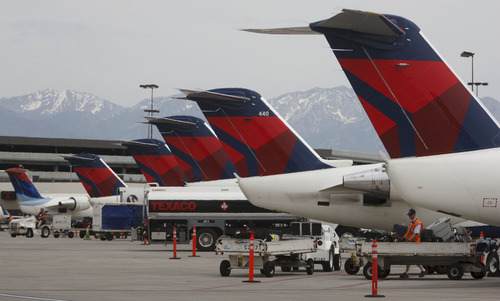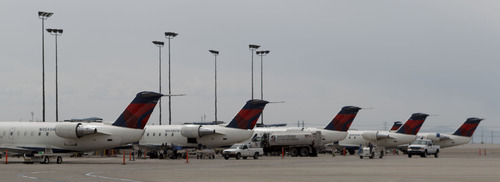This is an archived article that was published on sltrib.com in 2012, and information in the article may be outdated. It is provided only for personal research purposes and may not be reprinted.
As SkyWest Inc. rounded the corner into 2011, the country's largest regional airline was coming off another good year. Profits had made a solid gain, and the carrier had struck a deal to pay $133 million in cash for rival ExpressJet Holdings. The company was growing.
Just short of 18 months later, SkyWest is looking back at 2011 as the year when trends that had been subtly bubbling through the industry since the start of the recession began to seriously undermine the St. George-based parent of SkyWest Airlines and Atlantic Southeast Airlines, now called ExpressJet Airlines.
To be clear, even though SkyWest posted its first annual loss in years, the company is healthy. It sits on a mountain of cash, its balance sheet is one of the strongest in the airline industry, and although the stock has fallen back to pre-2000 levels, analysts continue to praise its management as among the best in the industry.
But with mainline airlines consolidating, making sharp cuts to routes and seats, and showing little appetite for modifying their compensation agreements with regional partners whose labor and airplane maintenance costs are rising, carriers such as SkyWest are being squeezed to the point where some analysts are asserting that the regional airline business model is broken.
"I just think that the model doesn't really work, because every time the major airlines get a chance to renegotiate their contracts with their regional partners, they push their operating margins down, and that obviously puts pressure on their earnings," said Helane Becker, with equity research firm Dahlman Rose and Co. in New York.
"I think SkyWest is one of the best-managed [regional airlines] of the group. But even they are not immune to the [fact that] the [regional] space is not in control of its revenue," Becker said.
She may be on to something. Analysts and airline executives say regional airlines are no longer a growth industry. Last month, when Pinnacle Airlines announced it had filed for Chapter 11 bankruptcy protection, CEO Sean Menke said the company's regional business model was no longer sustainable. Republic Airways, another big regional, reported a $152 million loss in 2011. Earlier this month, SkyWest President Brad Rich prefaced his discussion of the company's first quarter financial results by telling analysts that the industry was facing some stiff headwinds.
"We are acutely aware of the challenges that we've had, not only specifically to SkyWest and our companies, but the challenges and difficulties of our industry," Rich said. "There are a lot of things that are creating some distraction. There are a lot of our peers and others in the industry that are experiencing some difficulties."
Although the regionals' woes started only a few years ago, the groundwork was laid when the industry's original business model morphed into what it is today. In the early years, regional airlines, which usually fly between smaller destinations and major hubs under large airlines' names, were responsible for their own flights and ticket pricing. They bought their own fuel, paid for their own advertising and managed their own revenue. It was a model that SkyWest largely used until the mid-1990s.
In order to control costs and reduce risk, the industry gradually moved to the current model. They get most of their revenue from major airlines, which pay costs such as fuel and maintenance as they concentrate on longer routes to bigger destinations. In turn, the regionals are responsible for managing their cost structures.
Until recently, the model allowed regionals to be hugely profitable. In 2007, as the recession dawned, SkyWest banked a $159 million profit. By contrast, one of its major partners, Delta Air Lines, was operating under a bankruptcy court's protection for part of the year. Another partner, United Airlines, had exited bankruptcy in 2006.
To cope with the recession, mainline carriers began to cut seats and trim routes. Mike Kraupp, SkyWest's chief financial officer, saw that Delta was reducing SkyWest's block hours — the industry's measure of how long and often an airplane is in use. Delta also shortened the average distance that the aircraft in SkyWest's fleet flew, with the result that costs started to grow faster than the compensation it received. It wasn't just a Delta phenomenon, however. Kraupp said United tinkered with SkyWest's scheduling, too.
"There is significant pressure that's put on us from the major partners to simply decrease costs [instead of paying more]," Kraupp said. "I think in several instances we've seen where that pushing has caused problems.
"Have the majors pushed too far? I suspect that you'll get arguments on both sides of the table on that. But from our perspective, when you look at the cost structure that we have in place ... the majors are not compensating us [adequately] on certain portions of our fleet," Kraupp said, adding that SkyWest has asked Delta and United for help. The bigger airlines haven't responded yet, he added.
SkyWest flies for Delta as Delta Connection and for United as United Express. Virtually all of its fleet of 732 aircraft are assigned to the two airlines. Representatives of Delta and United didn't answer requests for comment on the industry's evolution.
Maintenance costs have become another point of friction. SkyWest's fleets are made up heavily of Bombardier regional jets. As they age, the cost to take care of them has become greater than SkyWest had been led to believe by the manufacturer. Maintenance costs increased by close to $226 million last year, and future reimbursements under SkyWest's agreements with its partners aren't expected to keep up with expenses, Kraupp said.
"It creates a case where we've got to go back to the majors and have conversations with them that say, 'The intent is for you to pay for these costs, plus a margin, and then we maintain the quality,' " he said.
SkyWest also is struggling to keep labor costs under control. Last year, salaries, wages and benefits made up 32 percent of the airline's operating expenses, and Kraupp sees little relief ahead. As mainline carriers consolidated and cut back capacity on unprofitable routes to help trim costs and support fuel prices, they also slowed hiring of pilots, many of whom gain experience at regional airlines before moving to larger airlines. That's created a demographic scenario where a lot of pilots are staying at SkyWest longer than the company expected.
How SkyWest resolves its problems isn't clear. The airline is waiting to hear whether Delta and United will help with its rising cost structures. One analyst, who would speak only on background, said SkyWest was big enough to have some leverage with its partners. But he added that the latter were going to be very aggressive in any negotiations and that SkyWest would need to be equally two-fisted.
Kraupp said part of the solution will have to involve other regional airlines, which he said have too often been undisciplined in their negotiations with mainline carriers for new business. They accept contracts that, in time, may not cover their costs.
In that regard, SkyWest has decided to draw a line in the sand. Kraupp said the airline recently turned down two deals that were proposed by a major carrier because they didn't pencil out. The latter apparently wasn't surprised. "They realized those deals were very, very thin," he said.
"You can't continue to chase [growth] just for growth's sake. That's where discipline has to come back in," Kraupp said. "We've drawn those lines in the sand and said, 'Look, here are the economics that we've got to have. We understand what you are asking as a major, but we've got to change the deal. In order for us to do continued business, here's how it's got to be structured.' "
A second component of the solution will involve SkyWest combing through its subsidiaries to look for new ways to save money. Kraupp said the airline has identified "buckets" of cost-savings that are showing results. Although SkyWest posted a $682,000 loss in the first quarter of this year, the shortfall was smaller than it expected, which means SkyWest Airlines and ExpressJet are ahead of plan.
Every bit as important, however, is getting SkyWest's partners to understand that compensation rates need to rise, Kraupp said. If they disagree, then SkyWest will have to return some of its aircraft when their leases expire. The company could actually shrink in size until its partners begin to expand their capacities again.
"We are not going to put ourselves in an irrational position, long term, because that's just not going to work," Kraupp said.
"It's not going to work for us. It's not going to work for employees and it's not going to work for shareholders."
Twitter: @sltribpaul —
Hard landing
SkyWest Inc.'s profits declined last year. A look at past performance:
2006 • $145.8 million
2007 • $159.2 million
2008 • $112.9 million
2009 • $83.7 million
2010 • $96.4 million
2011 • ($27.3 million)
2012 • ($682,000) First quarter





